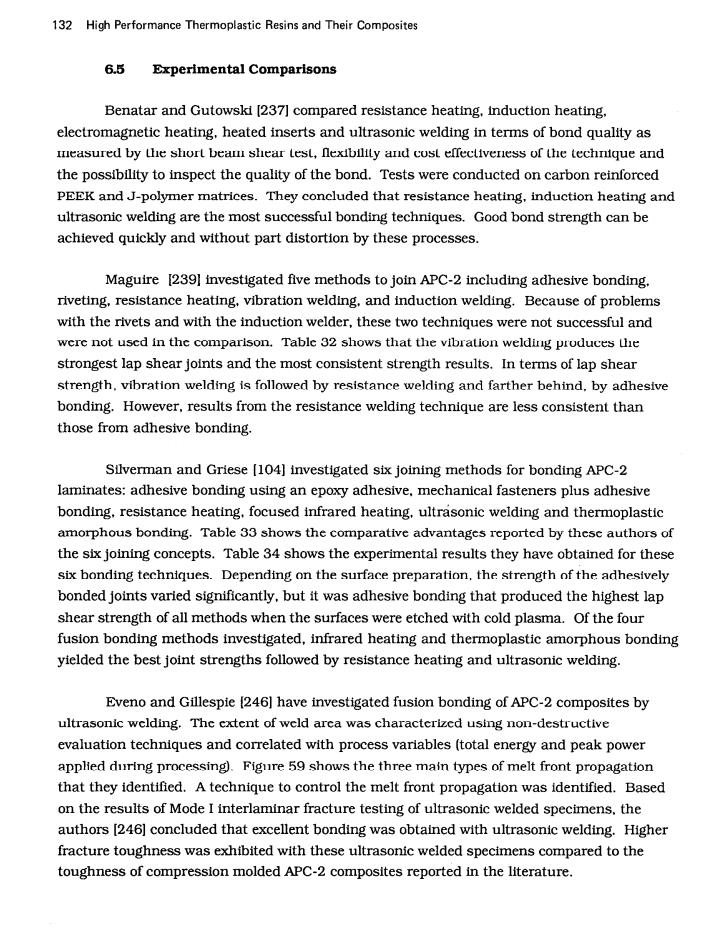正在加载图片...

132 High Performance Thermoplastic Resins and Their Composites 6.5 Experimental Comparisons Benatar and Gutowski[237]compared resistance heating,induction heating. electromagnetic heating,heated inserts and ultrasonic welding in terms of bond quality as measured by the short beam shear lest,flexibility and cost effectiveness of the technque and the possibility to inspect the quality of the bond.Tests were conducted on carbon reinforced PEEK and J-polymer matrices.They concluded that resistance heating,induction heating and ultrasonic welding are the most successful bonding techniques.Good bond strength can be achieved quickly and without part distortion by these processes. Maguire [239]investigated five methods to join APC-2 including adhesive bonding. riveting,resistance heating,vibration welding,and induction welding.Because of problems with the rivets and with the induction welder,these two techniques were not successful and were not used in the comparison.Table 32 shows that the vibration welding produces the strongest lap shear joints and the most consistent strength results.In terms of lap shear strength.vibration welding is followed by resistance welding and farther behind,by adhesive bonding.However,results from the resistance welding technique are less consistent than those from adhesive bonding. Silverman and Griese [104]investigated six joining methods for bonding APC-2 laminates:adhesive bonding using an epoxy adhesive,mechanical fasteners plus adhesive bonding,resistance heating.focused infrared heating.ultrasonic welding and thermoplastic amorphous bonding.Table 33 shows the comparative advantages reported by thesc authors of the six joining concepts.Table 34 shows the experimental results they have obtained for these six bonding techniques.Depending on the surface preparation.the strength of the adhesively bonded joints varied significantly,but it was adhesive bonding that produced the highest lap shear strength of all methods when the surfaces were etched with cold plasma.Of the four fusion bonding methods investigated,infrared heating and thermoplastic amorphous bonding yielded the best joint strengths followed by resistance heating and ultrasonic welding Eveno and Gillespie (246]have investigated fusion bonding of APC-2 composites by ultrasonic welding.The extent of weld arca was characterized using non-destructive evaluation techniques and correlated with process variables (total energy and peak power applied during processing).Figure 59 shows the three main types of melt front propagation that they identified.A technique to control the melt front propagation was identified.Based on the results of Mode I interlaminar fracture testing of ultrasonic welded specimens.the authors [246]concluded that excellent bonding was obtained with ultrasonic welding.Higher fracture toughness was exhibited with these ultrasonic welded specimens compared to the toughness of compression molded APC-2 composites reported in the literature.132 High Performance Thermoplastic Resins and Their Composites 6.5 Experimental Comparisons Benatar and Gutowski 12371 compared resistance heating, Induction heating, electromagnetic heating, heated inserts and ultrasonic welding in terms of bond quality as measured by the short beam shear test, flexibility and cost effectiveness of the technique and the possibility to Inspect the quality of the bond. Tests were conducted on carbon reinforced PEEK and J-polymer matrices. They concluded that resistance heating, Induction heating and ultrasonic welding are the most successful bonding techniques. Good bond strength can be achieved quickly and without part distortion by these processes. Maguire 12391 Investigated five methods to join APC-2 including adhesive bonding, riveting, resistance heating, vibration welding, and induction welding. Because of problems with the rivets and with the induction welder, these two techniques were not successful and were not used in the comparison. Table 32 shows that the vibration welding produces the strongest lap shear joints and the most consistent strength results. In terms of lap shear strength, vibration welding is followed by resistance welding and farther behind, by adhesive bonding. However, results from the resistance welding technique are less consistent than those from adhesive bonding. Silverman and Griese [ 1041 investigated six joining methods for bonding APC-2 laminates: adhesive bonding using an epoxy adhesive, mechanical fasteners plus adhesive bonding, resistance heating, focused infrared heating, ultrasonic welding and thermoplastic amorphous bonding. Table 33 shows the comparative advantages reported by these authors of the six joining concepts. Table 34 shows the experimental results they have obtained for these six bonding techniques. Depending on the surface preparation, the strength of the adhesively bonded joints varied significantly, but it was adhesive bonding that produced the highest lap shear strength of all methods when the surfaces were etched with cold plasma. Of the four fusion bonding methods investigated, infrared heating and thermoplastic amorphous bonding yielded the best joint strengths followed by resistance heating and ultrasonic welding. Eveno and Gillespie 12461 have Investigated fusion bonding of APC-2 composites by ultrasonic welding. The extent of weld area was characterized using non-destructive evaluation techniques and correlated with process variables (total energy and peak power applied during processing). Figure 59 shows the three main types of melt front propagation that they identified. A technique to control the melt front propagation was identified. Based on the results of Mode I interlaminar fracture testing of ultrasonic welded specimens, the authors 12461 concluded that excellent bonding was obtained with ultrasonic welding. Higher fracture toughness was exhibited with these ultrasonic welded specimens compared to the toughness of compression molded APC-2 composites reported in the literature